Science road trip
In the summer of 1928, the young Ernest O. Lawrence set out across America in a Flying Cloud coupe to begin his new life at the University of California, Berkeley. Eighty-one years later, a writer and a photographer took a road trip to visit the legacy of this accelerator-physics pioneer: American Big Science.
Text by Lizzie Wade & photos by Nick Russell
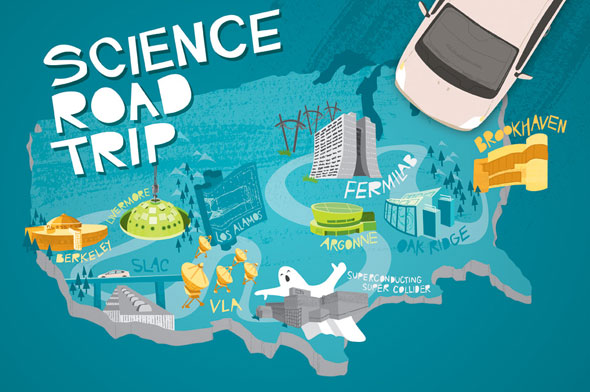 |
| Illustration: Sandbox Studio |
Every good cross-country road trip needs a theme. Sure, you can drive across the United States in three days flat, heading in a straight line on impersonal interstates and stopping at the occasional Waffle House for sustenance. But that doesnt do justice to the great American tradition of the road trip, heading from sea to shining sea with the windows down and the radio on. From On the Road to Easy Rider, weve learned that the destination isnt the point—its how you get there that counts.
So when my boyfriend Nick Russell and I decided to drive from New York City to Los Angeles last summer, we weighed various options for our theme: The always-classic National Parks? The quirkier tour of Elvis museums? Major cities? Small towns? Desert, mountains, prairie?
Uninspired, we threw out ideas for stops along the way. Marfa, Texas— good art, family friends, and UFO lights in the desert. Pueblo, Colorado—the Rocky Mountains, a friends parents, and Casa Bonita, a cross between a Mexican restaurant and Disneyland. Petersburg, Kentucky—the Creation Museum, devoted to disproving evolution, which we ultimately decided was not for us. And then we remembered Chicago, Illinois—a cousin with a spare bedroom and Fermi National Accelerator Laboratory, where Id worked as a science-writing intern for a summer in college. The idea snowballed from there, and soon our itinerary included visits to eight Department of Energy national laboratories (Brookhaven, Oak Ridge, Fermilab, Argonne, Los Alamos, Berkeley, Livermore, and SLAC), one NASA lab (the Jet Propulsion Laboratory), one gigantic radio telescope (the Very Large Array), and one ghost lab in East Texas (the abandoned site of the Superconducting Super Collider).
Big Science through human eyes
Our lab-to-lab trek meandered all over the country, taking us through rolling green hills in Tennessee, a flash flood in Indiana, misty forests in Arkansas, the wizened desert of West Texas, and the winding California coast. But the route also presented some challenges: it zigzagged wildly (those rolling hills in Tennessee were beautiful, but Im not sure we needed to see them twice in one week) and the logistics of arriving at each lab on a working weekday meant we often drove until well into the night. Blame it on fatigue, but we mistook a power plant for the Oak Ridge lab. One late night we wondered if we were about to be abducted by aliens as we drove through a seemingly endless field of red lights flashing in unison in the middle of Texas (we never did figure out what they were). Eventually, we even started to appreciate the idea of a drive-through Starbucks.
The trip was as much a physical experience as an intellectual one. Just as theres no way to grasp the amount of empty space in the United States until youve driven through it, theres no way to comprehend how big Big Science is until you stand on a plateau in New Mexico trying to catch sight of the most distant satellite dish in the Very Large Array, which at its widest point would span Washington, DC; or stand under the recently finished National Ignition Facility at Lawrence Livermore National Lab, which looks like a prototype for the Star Wars Death Star, right down to the intersecting laser beams.
Driving continuously from one lab to the next also humanized Big Science in surprising ways. We had to sleep somewhere, and that often turned out to be at a lab employees house. In the space of a few hours, Fermilabs Kurt Riesselmann shifted from giving us a tour of the latest developments in technology for the proposed International Linear Collider to explaining how his washing machine worked so we could do some much-needed laundry. At Brookhaven we bunked with the run coordinator for the Relativistic Heavy Ion Collider, John Haggerty, who didnt even make it home because a surprise thunderstorm threatened the labs power supply.
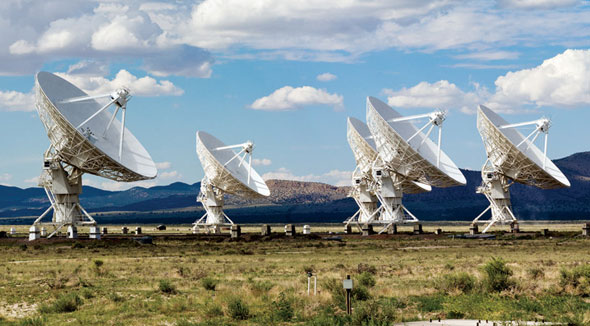 |
| Enormous scale was the theme of our trip, but nothing compared with the city-sized Very Large Array, stretching off in three directions into the vast New Mexico desert. |
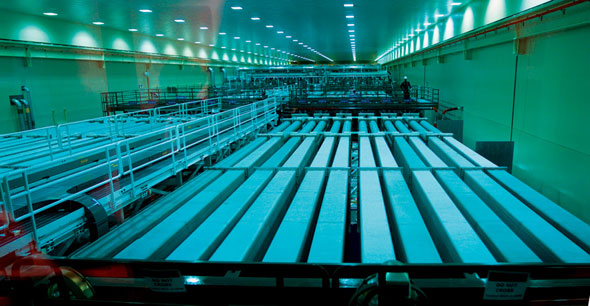 |
| One of two laser bays at Livermores National Ignition Facility, where 192 powerful lasers are focused onto a target the size of a pin in an attempt to cause nuclear fusion. |
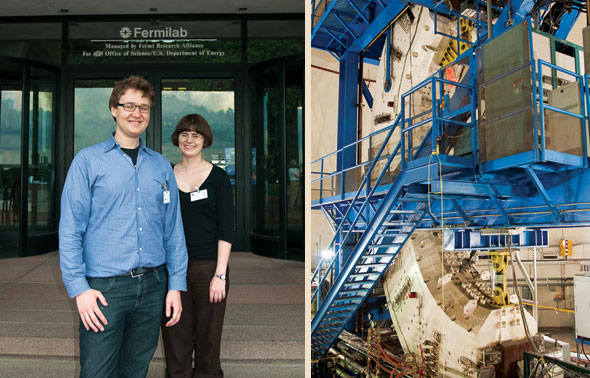 |
| Left: Nick and Lizzie at Fermilab; photo by Kurt Riesselmann. Right: Los Alamos's proton radiography imager uses protons instead of photons to make detailed internal images of small explosions, allowing scientists to test aging nuclear weapons without detonating them. |
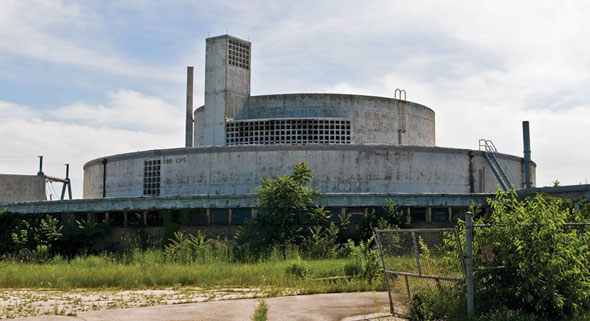 |
| History is everywhere at the national labs. At Argonne, we almost drove right past the building that formerly housed the 1950s-era Chicago Pile 5 reactor. |
 |
| Left: Scientists in the control room for Brookhavens Relativistic Heavy Ion Collider attempt to fix a problem that had shut the collider down for several hours. Right: The view from Oak Ridges cafeteria includes a waterfall and a building that houses one of the worlds most powerful Van de Graaf generators. |
 |
| Left: When NASAs Spirit rover got stuck in Martian sand, Jet Propulsion Laboratory scientists used their spare rover to figure out how to get it out. Sadly, Spirit had to be redesignated as a Stationary Research Platform on Day 2157 of its 90-day mission. Right: At SLAC, we stumbled across gas tanks labeled by the Atomic Energy Commission, which ceased to exist in 1974. |
Extra-ordinary scenes
Next on the road trip survival list was eating, frequently in lab cafeterias. Lunch was often the most informative part of a visit, with a wide variety of people dropping by our table to say hi to our scientist tour guides, breaking the façade of experimental rivalries and giving us a sense of the camaraderie in each lab. The social dynamics often seemed familiar and even mundane. Like all large organizations, national laboratories have their share of office politics, gossip, and administrative struggles—and even cubicles, whether they are located in high rises, in trailers, or between the arms of a synchrotron.
But just when things started to look too ordinary, we spotted the building at Argonne that housed the Chicago Pile 5 reactor, last in Enrico Fermis famous line of Chicago-Pile reactors; remembered that another version of the rover we were examining at the Jet Propulsion Laboratory was exploring Mars at that very moment; spotted an old gas canister labeled Property of the Atomic Energy Commission at SLAC; or encountered one of the discoverers of dark energy in a hallway at Berkeley Lab.
Even the machines themselves have distinct personalities. There is always troubleshooting to be done on even the most state-of-the-art equipment, and many of the machines at the national labs are far from new, having been repaired and upgraded dozens of times since they first came on line. Oak Ridge, for example, has been using the same cyclotron to accelerate particles since 1962. Parts of Brookhavens PHENIX detector are plastered with packing tape. Detector computer rooms brim with tangled cables. And many of the sensitive physics machines we saw were at least partially covered in aluminum foil.
Yet if this image seems chaotic, it showcases the deepest truth we encountered this summer: American experimental physics remains deeply resourceful and hands-on. When a part breaks, it is as likely to be fixed as replaced. When a detector isnt functioning as well as it could, someone is likely to step up and figure out a way to make it better. And when a machine becomes obsolete, it stands a good chance of being incorporated into the next big project.
The road to the 21st century
High-energy physics machines may have long life spans, but high-energy physics is just a century old, starting with Ernest Rutherfords discovery of the atomic nucleus in 1911. Since much of the field developed within living memory, the history is often still visible, or even in use. Ernest O. Lawrences first cyclotron, small enough to hold in your hand, is on permanent display at UC Berkeleys public science center, the Lawrence Hall of Science. The magnet for his last cyclotron can be found right where he left it at the Rad Lab (now Lawrence Berkeley National Laboratory), where it supports a giant crane in the labs synchrotron, the Advanced Light Source.
American high-energy physics came into its own when World War IIs Manhattan Project sequestered many of the worlds best physicists in the mountains of New Mexico to work on the atomic bomb. For an effort so classified that it justified building the secret atomic cities of Los Alamos, New Mexico, and Oak Ridge, Tennessee, the Manhattan Projects history is surprisingly accessible today. Even Oak Ridges graphite reactor—one of the worlds first nuclear reactors, used to perform early nuclear research and process plutonium for the first atomic bombs—was simply powered down after a flood in 1963 and kept intact for visitors to explore.
Although the town of Los Alamos is now a thriving community, its hard to visit without feeling unease at the weight of its history. Besides the massive lab itself, the town houses a small museum full of Manhattan Project artifacts and Cold War paraphernalia, as well as the lab-run Bradbury Science Museum where, among many other displays, you can see scale models of the two early bomb designs and browse the ID photos of the labs Manhattan Project residents. The young Hans Bethe, Robert Oppenheimer, Edward Teller—and the very young Richard Feynman—are particular standouts. A bookstore adjacent to the science museum even sells blueprints of Little Boy and Fat Man, the atomic bombs dropped on Hiroshima and Nagasaki in 1945.
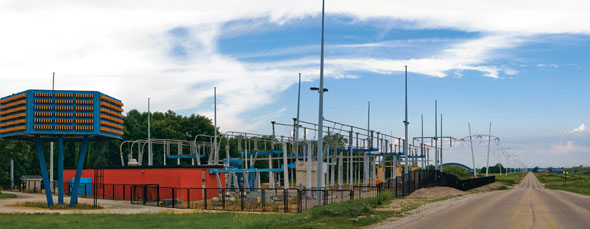 |
| Robert Wilsons eccentric design tastes help make Fermilab unique. In addition to power poles shaped like the Greek letter π, the lab has more than its share of strangely shaped orange and blue structures. |
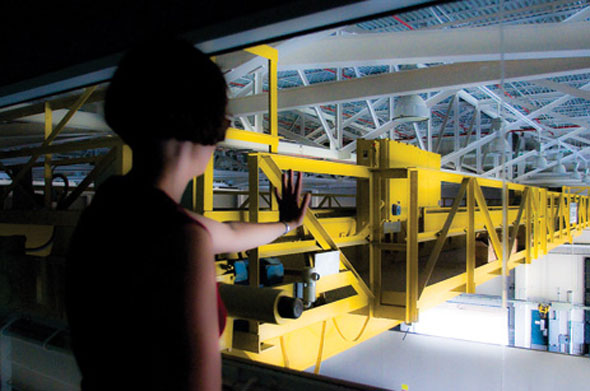 |
| Lizzie overlooks the ceiling crane that scientists would have used to build components for the Superconducting Super Collider if the project hadnt been cancelled in 1993. |
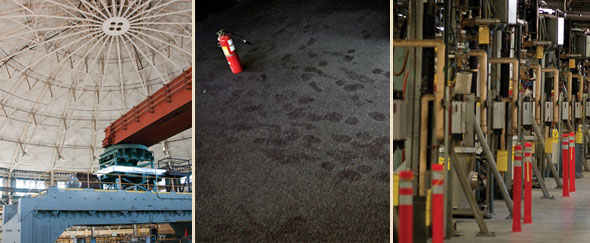 |
| Left: Part of Ernest Lawrences last, biggest cyclotron is still housed in his Rad Lab—though today the building is home to Berkeley Labs Advanced Light Source, and the magnet yoke of the cyclotron is all thats left, supporting a massive crane. Center: A commenter on our blog made these eerie footprints inside the abandoned SSC magnet assembly building. Right: Microwave cavities for SLACs two-mile linear accelerator extend off into the distance. Today, the linac powers an X-ray laser. |
Ghosts of physics past
After the Manhattan Project ended, the government continued its strong support of high-energy physics research. As with the Space Race, beating the Soviets to the frontiers of physics was considered an integral part of national security and pride, even when the discoveries had no military application whatsoever. Former Fermilab director John Peoples told us that the US government was willing to supply its scientists with the resources needed to meet this end. He recalled that when Fermilabs founding director, Robert Wilson, asked Congress for the money to build the laboratory, they gave him $90 million and told him to come back if he needed more. Construction was completed ahead of time and under budget, in part because Wilson himself designed many of the more imaginative buildings, which still stand as testaments to a particularly dynamic era in American particle physics.
That era came to an end in 1993 with the cancellation of the Superconducting Super Collider, whose ghost still haunts high-energy physics. With a 54-mile circumference, the underground tunnels of the SSC would have encircled an area comparable to the city of Dallas and surrounded the small city of Waxahachie, Texas. It would have had nearly three times the power of Europes new Large Hadron Collider, now the worlds most powerful particle accelerator, and would have almost certainly revealed the Higgs boson (if it exists) along with many other results that physicists are still waiting for today. But with the end of the Cold War, the race with the Soviets lost its urgency and high-energy physics could no longer assume a privileged place among government science programs. When the SSCs projected cost soared billions of dollars over budget, Congress pulled the plug—leaving several buildings and 14 miles of tunnel abandoned in rural East Texas.
Although officially owned by a Texas investment company, these days the SSC is a ghost lab. A cluster of warehouses, empty except for the ceiling cranes still waiting to assemble a detector, loom over a few holes in the ground that lead down to the water-filled accelerator tunnel. The only signs that we werent the first visitors in almost 20 years were an abandoned couch in a driveway, some ghostly footprints on the carpet inside, a half-empty Frappuccino bottle in an office cabinet, and, most crucially, the busted window pane we used to sneak into the main building.
New opportunities
The SSC certainly represents a missed opportunity in the history of high-energy physics, but its cancellation hasnt stopped the field from moving forward on many different fronts. Fermilab, now the nations only dedicated particle-physics lab, is expanding its focus to include a high-intensity neutrino physics program, even while the high-energy Tevatron collider continues to search for the Higgs boson and other exciting new physics. Interdisciplinary fields like photon science are drawing unprecedented amounts of attention at several national labs, along with supercomputing and energy science. Physicists continue to develop technologies for the accelerators of the future, which may include schemes to make Big Science smaller with breakthroughs that could shrink giant particle accelerators to tabletop size. And thousands of US physicists are collaborating with researchers from all over the world on experiments at CERNs Large Hadron Collider.
Faced with all these new opportunities, American Big Science must continually ask itself the same question we confronted as we pondered Google Maps directions: where do we go from here?
For more pictures and an in-depth look at the science going on at each lab we visited, check out our blog: summerofscience.wordpress.com
Click here to download the pdf version of this article.






